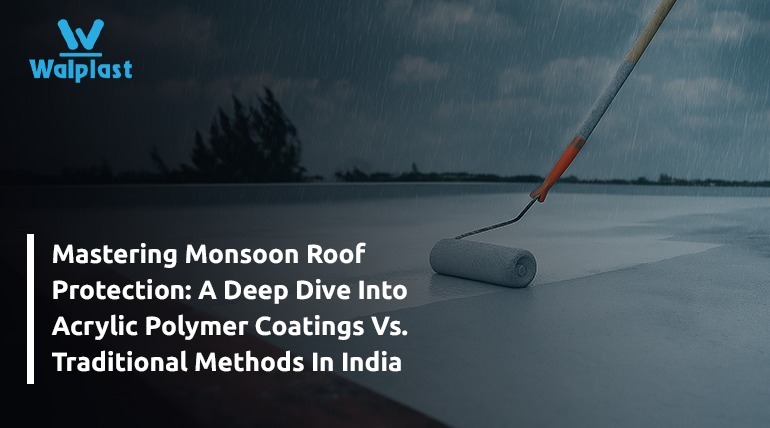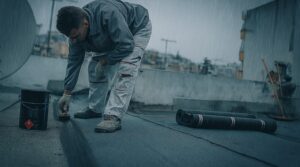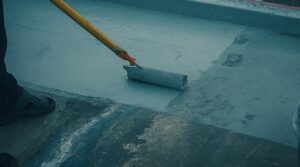
The surging popularity of acrylic polymer coatings highlights a flexible, durable, and affordable solution designed to be monsoon resilient, effectively shielding roofing materials such as concrete, metal, and asphalt shingles from leaks, corrosion, and degeneration by forming a smooth, impermeable barrier. India’s monsoons deliver heavy, sustained rain, causing flat roofs to suffer from water pooling and sloped roofs to face seepage.
Conventional materials like bitumen and cement slurries, designed years ago, often struggle under climate change and intense monsoons. Carrying out effective roof waterproofing is essential to arrest moisture infiltration, expensive repairs, and structural deterioration, guaranteeing a dry and secure home environment.



Acrylic polymer coatings: the modern approach
Acrylic Polymer Coatings are normally UV-resistant and hydrophobic, which do not dissolve in water. However, modified acrylic polymers engineered into water-soluble compounds are a genius invention for waterproofing. These waterproofing chemicals form a protective film on the rooftop, acting as a flexible, joint-free membrane. In these coatings, while the additives deliver performance and durability, the water acts as a carrier.Acrylic Polymer Coatings vs. Traditional Methods
| Modern Method | Traditional Methos | |||
| Parameter | Acrylic Polymer Coating | Bitumen Coating | Brick Bat Coba | Lime Terracing |
| Waterproofing Performance | Seamless flexible membrane | Good initially, but degrades over time | Rigid | Moderate; Non-Flexible |
| Crack Bridging Ability | High; elastomeric 300% elongation | Brittle, cracks under stress | Low, rigid surface does not flex | Low; inflexible and cracks under pressure |
| UV Resistance | High; resists sunlight and degradation | Non UV Proof | Non UV Proof | Low; erodes under prolonged UV exposure |
| Thermal Insulation | Reflective white coatings (5-10 degree) | No, absorbs and retains heat | Good insulation properties | Good insulation properties |
| Handling Temperature Variations | Withstands thermal expansion and contraction | Poor; fails under high heat or extreme cold | NO | No |
| Application Time | Fast; brush/roller applied in layers | Moderate; requires heating and layering | Time-consuming and labour-intensive | Time-consuming and labour-intensive |
| Ease of Maintenance | Easy to recoat or repair (no removal required) | Easy but messy and very frequent | Difficult; involves breaking layers for repair | Difficult; requires skilled labour for any repair |
| Aesthetics | Good; smooth, coloured finish options available | Black messy surface | Cemented finish | Dull reddish appearance |
| Weight on Structure | Almost Nil | Lightweight | Very Heavy | Very Heavy |
| Eco-Friendliness | Low-VOC | Petroleum-based, non-biodegradable | Natural materials but energy- and labour-intensive | Eco-friendly but lacks modern viability |
| Initial Cost | Moderate | Low to moderate | High labour cost | High labour cost |
| Life Cycle Cost | Low | High | Moderate | Low |
| Skilled Labour Availability | Easily available | Easily available | Decreasing availability of skilled masons | Rare; very few skilled lime workers now available |
| Best Use Case | Modern homes, terraces, factory sheds, high rise | Low-budget or temporary protection | As per old government space | Heritage structures or traditional homes only |
Advantages of Acrylic Polymer Coatings for Roof Waterproofing
Acrylic polymer coatings are engineered, manmade materials designed to deliver superior waterproofing performance. When mixed with water and applied, they form a flexible, durable membrane with several key advantages:
- Elasticity to Withstand Temperature Fluctuations
- Excellent Crack Bridging
- High Water Resistance
- Superior UV Resistance
- Environmentally Friendly
- Maintenance Friendly
The final word on waterproofing
Protecting an Indian home from the monsoon’s relentless challenges truly hinges on reliable roof waterproofing. Whether through proven traditional methods or advanced polymeric coatings like Walplast’s HomeSure Mastertouch Waterlock, effective solutions create a durable, anti-seepage barrier against water damage. Investing in the right materials and techniques ensures your home’s integrity and brings lasting peace of mind, safeguarding against cracks and leaks on roofs, terraces, and vertical walls.
Tags Roof Waterproofing WaterLockCategories Blog Waterproofing
